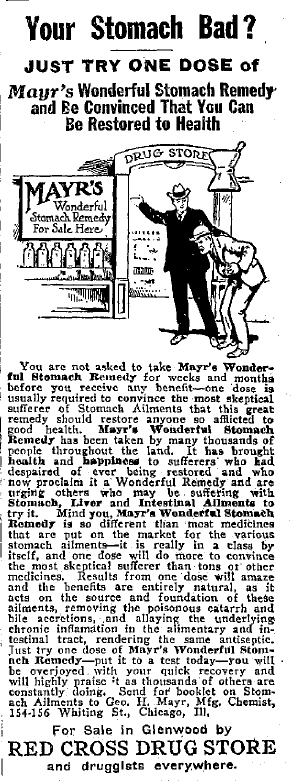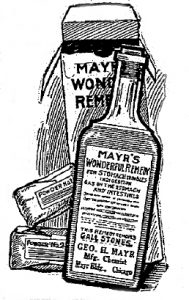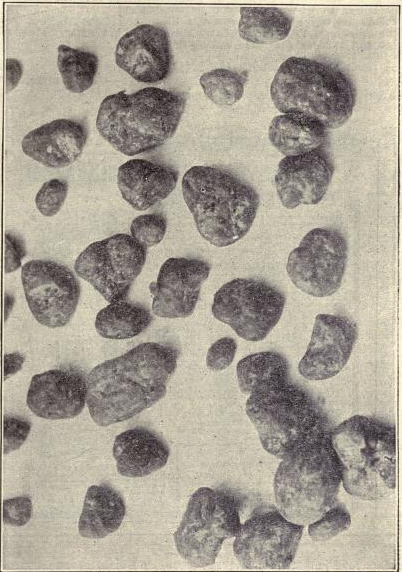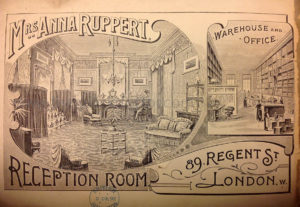
Some secret remedies remain secret for centuries. Not Mayr’s Wonderful Stomach Remedy. Within about a year of it becoming famous, a Chicago newspaper was describing its promoter as a ‘comical quack’ and ‘one of the most entertaining medical fakers in Chicago.’
The Stomach Remedy was inspired by the methods of the itinerant con-artists who worked the small towns of the US in the late 1800s. In the early 20th century, similar products began appearing in the advertising columns, and druggist George H Mayr was quick to get in on the act. Described by the A.M.A. as ‘the fake gallstone trick,’ his method provided patients with immediate, visible results so convincing that the testimonials flooded in.
Mayr was evangelical about his medicine’s properties:
I have watched sick people for years and have reached out my hand to thousands in the great depth of the Valley of Despair and brought them into the light of life and happiness. I want you, and each one suffering, to know the full joys of living with every part of your system in beautiful accord and absolute perfect harmony.
His remedy comprised a bottle of medicine and two sachets of powders. The patient had to take the first powder at about 3pm, then the whole contents of the bottle before bed, then the second powder in the morning. All going to plan, there should be spectacular results:
When the bowels operate, use a vessel and note the poisonous secretions removed by this remedy, in some cases dark green or yellow lumps varying in size from a fine bead to an olive – in severe cases even larger. In other cases quantities of thick tenacious slime or mucous.

Mayr claimed that it was an old French remedy, used for generations to ‘relieve all stomach ailments and keep the bowels free from foul, poisonous matter.’ France, he said, was ‘the nation without stomach troubles.’
Whatever the state of our Gallic friends’ alimentary canals, Mayr’s medicine bottle contained nothing more interesting than olive oil. The powders were flavoured with licorice but other than that, analyses varied. One said they were mainly Rochelle salt (potassium sodium tartrate) while another suggested that one sachet contained Epsom salts (magnesium sulphate) and the second a sodium phosphate.
Either way, the patient would expel greenish waxy globules that looked a bit like stones. The A.M.A.’s report concluded that these were a mixture of fatty acids and soap caused by the alkaline intestinal fluids operating on the oil. Anyone taking the remedy and cheerfully rummaging through their subsequent excretions would get the same result, regardless of whether or not they had anything wrong with them.

Mayr’s dodginess extended to his advertising methods too. In 1918, the New York Tribune revealed that he sent round a list of instructions to editors, giving them advertising copy like this…
………… SOLDIER UNDER FIRE
“We have had several brushes with the enemy since reaching the trenches here, which I am sure I would not have reached had it not been for Mayr’s Wonderful Stomach Remedy. It has entirely cured me of indigestion and awful gas in my stomach. Army food now digests as good as mother’s used to.”
The newspaper was supposed to fill in the blank in the headline with the name of its own town, to present the imaginary soldier as a local lad. The Tribune was quick to take the moral high ground against the papers that accepted this form of advertising, saying rather self-righteously:
But the publisher who cooperates with the quack by deliberately printing what he knows to be a lie is guilty of unspeakable treachery to those who believe what they read in his paper.
Mayr wasn’t the only one to use this advertising ploy, and not the only one promoting the oils-and-salts method. A hundred years later, a similar process called the liver cleanse or liver flush is still going strong. The difference is that now we have the internet, where people can (and do) post pictures of their poo to show off the wonderful things therein. A link to such biological delights is not necessary on a history site, but you’re big enough and ugly enough to do a bit of Googling if you desperately want to know.
.
.



I am an archaeologist and found a bottle at a dig site with the writing “Mayr’s Wonderful Remedy, Chicago, U.S.A.” A Google search brought my to your blog entry and I learned a lot! Thanks so much for your post!
Wow, what horrible things you say about my Great Uncle George. Bet you’re a picture of perfection.
Hi Jan – thank you for visiting the site. I am very far from being perfect and that’s one of the main reasons why I have such an interest in and affection for the less-than-saintly characters of human history.
When approaching stories like this, I fully consider how I’d feel to find negative newspaper reports about my own ancestors, and I conclude that I would be delighted and fascinated. I can assure you that if I unearthed similar sources about my own family history I wouldn’t hesitate to blog about them in the same style. I appreciate, however, that not everyone feels the same so I apologise for causing you offence.
He is my great uncle as well. I met him several times in his Beverly Hills house. He died when I was nine. He was a very nice man who made the bulk of his wealth in California real estate, and used his wealth to fund college scholarships. His foundation is still active. But he will always be known as a quack. Our family always knew he had been a druggist in Illinois prior to coming to CA, but about the Mayr Wonderful Remedy.
I’m no archaeologist, but I sometimes find pieces of bottles and other glassware on our farm. Thanks to your site, I was able to determine that a piece of clear glass I found this morning is part of a Mayr’s bottle. I’d love to see what the whole bottle looked like. My fragment says …AYR’S on one line and STOMA… on the next and then CH… (for Chicago, I assume) on the last line. I’m left to wonder which ancestor had stomach trouble.
I found a Mayr’s bottle this week on a beach site near Scammon’s Lagoon in Baja California Sur.